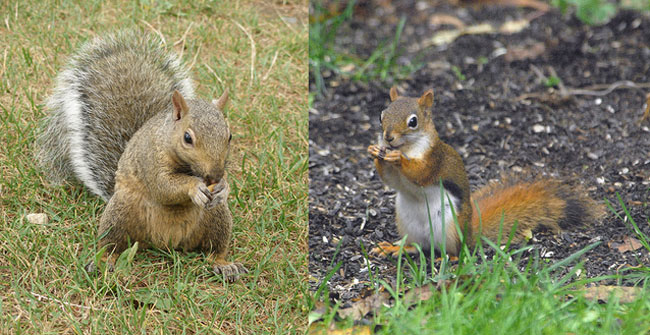Comparing Gray Squirrels and Red Squirrels
By Chris Williams on August 3, 2013.

Question
What’s the difference between gray squirrels and red squirrels? We just moved into a new house and we’re seeing what I assume are red squirrels. I didn’t even know we had more than one type of squirrel in Massachusetts.
Answer
We actually have three types of tree squirrels, including the flying squirrel. Then there are the ground squirrels, but that’s another blog. Gray squirrels and red squirrels have a lot of similarities and a few noticeable differences in their habits. Both squirrels require woods for food and survival. Gray squirrels prefer hardwood forests with oak or other nut trees. Red squirrels require coniferous forests with cone-bearing trees. You’ve probably moved for the first time to a property with pine trees which means red squirrels.
Appearance
Gray squirrel
about 15-20 inches long, including a 6-9 inch tail. Weight ¾ to 1½ lbs. Color gray with white on chin, throat, and belly (black varieties occur in certain regions).
Red squirrel
Smaller than the gray, about 10½ -15 inches long, including a 3½ to 6 inch tail. Weight 1/2 to 5/8 lbs. Color rusty brown on the back with white or gray-white belly. In winter, sports tufts of hair on tips of ears.
Habitat
Gray squirrel
Found in mature hardwood forests, especially oak and hickory woods, occasionally in coniferous forests. Common in suburbs with large shade trees.
Red squirrel
Found in coniferous forests with pine, spruce, fir, or hemlock trees. In suburbs, found in small stands of pines or mixed woodlots.
Foods
Gray squirrel
Feeds on a variety of seasonal foods but nuts such as oak acorns, hickory nuts, beech nuts, and walnuts may make up ¾ of their diet. Also eats berries, fruits, seeds, flowers, grains. Actively gathers nuts in the fall and buries them randomly.
Red squirrel
Feeds mostly on seed cones of hemlock, pine, spruce, and fir trees. Large piles of broken up cones can be found under their feeding perches, or in brush piles, old burrows, stone walls, sheds, attics. Also eats fungi, buds, bark, nuts, grains, insect larvae, bird nestlings, and will bite into maple trees to lap up syrup.
Habits
Gray squirrel
solitary nester (young remain with female) but somewhat sociable, not territorial. Makes leaf nests and also uses tree holes for nesting. Will also nest in attics. Active at dawn and dusk during most of the year, but active only at midday in winter. Easily adapts to people.
Red squirrel
Solitary nester (young remain with female) and territorial. Prefers leaf nests over cavities, sometimes nests in rock dens or burrows. Less common in occupied buildings than the gray squirrel but readily nests in cabins. Active during the day, but may be inactive during very cold weather or the heat of midday. Very noisy with alarm calls, barking, chattering, and clicking sounds. Nervous and wary when on the ground; prefers the safety of trees.
Photo credit: quinet / Foter / CC BY
Photo credit: NDomer73 / Foter / CC BY-NC-ND